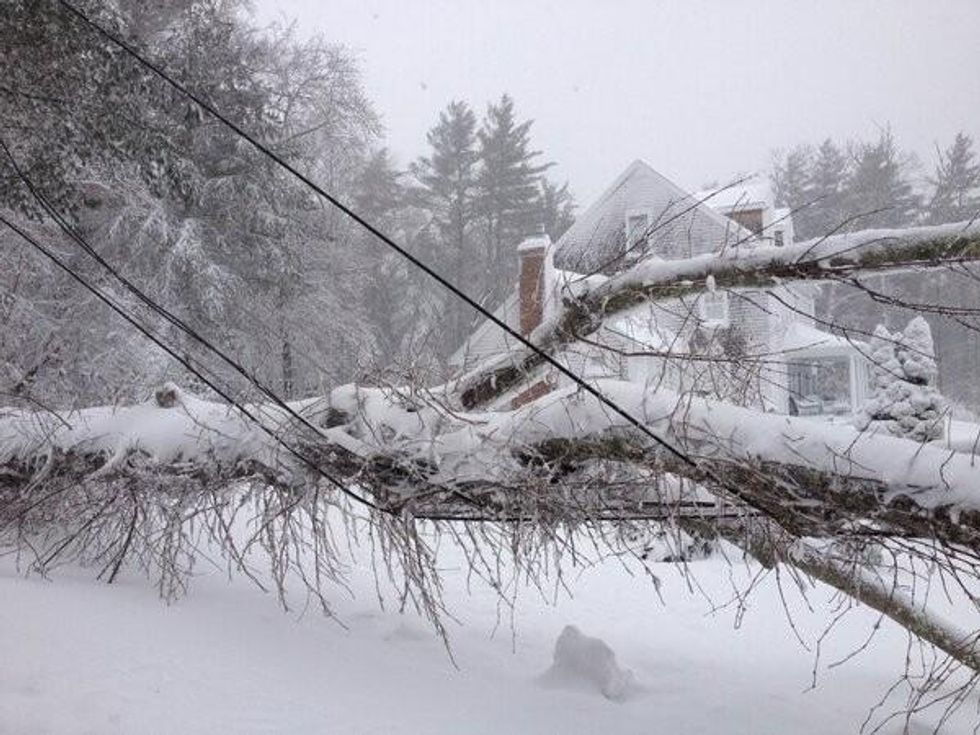"Slam Dunk" Blizzard Buries Northeast US
'A fact' of warmer times: fierce winds, power outages and chest-high snow drifts

As of Saturday afternoon, the storm--dubbed "Nemo" by the weather channel in what NPR refers to as the recurrent "hype cycle" of storms--had claimed four lives and left over 650,000 region residents without power.
Downed power lines left some 400,000 without power in Massachusetts alone, where up to two feet of snow was recorded throughout the state.
The Nuclear Regulatory Commission announced that Pilgrim Nuclear Power Plant in Plymouth, Mass. experienced an automatic shutdown at around 9:15 p.m. Friday after fierce winds caused it to lose off-site power. According to spokesman Neil Sheehan, backup generators are currently powering plant equipment.
As the morning high tide peaked around 10 am, members of the Massachusetts National Guard rushed to coastal communities to evacuate shoreline residents.
"What were streets a little while ago could look like canals in a lot of these towns up and down the coast," said MEMA spokesman Peter Judge.
The Blizzard left its mark as Portland, Maine's greatest snowstorm on record with more than 32 inches. And in Connecticut, where snow fell at a rate of up to five inches an hour, 38 inches of snowfall are estimated thus far.
Climatologists have been quick to point out that an increase dramatic storms, including nor'easters, are another effect of our quickly warming planet.
In this case, the combination of atmospheric moisture and slightly-below-freezing temperatures contributed the "perfect setup for a big storm," said Kevin Trenberth, of the Climate Analysis Section at the National Center for Atmospheric Research in Colorado.
"In the past, temperatures at this time of year would have been a lot below freezing," Trenberth said, which would have been too cold to hold the moisture needed to crystallize water into snow. "The atmosphere's ability to create those snowflakes drops by 4 percent for every one degree Fahrenheit fall in temperature," the Huffington Post reports.
"Storms like this tend to be heavier than they used to be," said Princeton climate change expert Michael Oppenheimer. "That's a fact."




An Urgent Message From Our Co-Founder
Dear Common Dreams reader, The U.S. is on a fast track to authoritarianism like nothing I've ever seen. Meanwhile, corporate news outlets are utterly capitulating to Trump, twisting their coverage to avoid drawing his ire while lining up to stuff cash in his pockets. That's why I believe that Common Dreams is doing the best and most consequential reporting that we've ever done. Our small but mighty team is a progressive reporting powerhouse, covering the news every day that the corporate media never will. Our mission has always been simple: To inform. To inspire. And to ignite change for the common good. Now here's the key piece that I want all our readers to understand: None of this would be possible without your financial support. That's not just some fundraising cliche. It's the absolute and literal truth. We don't accept corporate advertising and never will. We don't have a paywall because we don't think people should be blocked from critical news based on their ability to pay. Everything we do is funded by the donations of readers like you. Will you donate now to help power the nonprofit, independent reporting of Common Dreams? Thank you for being a vital member of our community. Together, we can keep independent journalism alive when it’s needed most. - Craig Brown, Co-founder |

As of Saturday afternoon, the storm--dubbed "Nemo" by the weather channel in what NPR refers to as the recurrent "hype cycle" of storms--had claimed four lives and left over 650,000 region residents without power.
Downed power lines left some 400,000 without power in Massachusetts alone, where up to two feet of snow was recorded throughout the state.
The Nuclear Regulatory Commission announced that Pilgrim Nuclear Power Plant in Plymouth, Mass. experienced an automatic shutdown at around 9:15 p.m. Friday after fierce winds caused it to lose off-site power. According to spokesman Neil Sheehan, backup generators are currently powering plant equipment.
As the morning high tide peaked around 10 am, members of the Massachusetts National Guard rushed to coastal communities to evacuate shoreline residents.
"What were streets a little while ago could look like canals in a lot of these towns up and down the coast," said MEMA spokesman Peter Judge.
The Blizzard left its mark as Portland, Maine's greatest snowstorm on record with more than 32 inches. And in Connecticut, where snow fell at a rate of up to five inches an hour, 38 inches of snowfall are estimated thus far.
Climatologists have been quick to point out that an increase dramatic storms, including nor'easters, are another effect of our quickly warming planet.
In this case, the combination of atmospheric moisture and slightly-below-freezing temperatures contributed the "perfect setup for a big storm," said Kevin Trenberth, of the Climate Analysis Section at the National Center for Atmospheric Research in Colorado.
"In the past, temperatures at this time of year would have been a lot below freezing," Trenberth said, which would have been too cold to hold the moisture needed to crystallize water into snow. "The atmosphere's ability to create those snowflakes drops by 4 percent for every one degree Fahrenheit fall in temperature," the Huffington Post reports.
"Storms like this tend to be heavier than they used to be," said Princeton climate change expert Michael Oppenheimer. "That's a fact."





As of Saturday afternoon, the storm--dubbed "Nemo" by the weather channel in what NPR refers to as the recurrent "hype cycle" of storms--had claimed four lives and left over 650,000 region residents without power.
Downed power lines left some 400,000 without power in Massachusetts alone, where up to two feet of snow was recorded throughout the state.
The Nuclear Regulatory Commission announced that Pilgrim Nuclear Power Plant in Plymouth, Mass. experienced an automatic shutdown at around 9:15 p.m. Friday after fierce winds caused it to lose off-site power. According to spokesman Neil Sheehan, backup generators are currently powering plant equipment.
As the morning high tide peaked around 10 am, members of the Massachusetts National Guard rushed to coastal communities to evacuate shoreline residents.
"What were streets a little while ago could look like canals in a lot of these towns up and down the coast," said MEMA spokesman Peter Judge.
The Blizzard left its mark as Portland, Maine's greatest snowstorm on record with more than 32 inches. And in Connecticut, where snow fell at a rate of up to five inches an hour, 38 inches of snowfall are estimated thus far.
Climatologists have been quick to point out that an increase dramatic storms, including nor'easters, are another effect of our quickly warming planet.
In this case, the combination of atmospheric moisture and slightly-below-freezing temperatures contributed the "perfect setup for a big storm," said Kevin Trenberth, of the Climate Analysis Section at the National Center for Atmospheric Research in Colorado.
"In the past, temperatures at this time of year would have been a lot below freezing," Trenberth said, which would have been too cold to hold the moisture needed to crystallize water into snow. "The atmosphere's ability to create those snowflakes drops by 4 percent for every one degree Fahrenheit fall in temperature," the Huffington Post reports.
"Storms like this tend to be heavier than they used to be," said Princeton climate change expert Michael Oppenheimer. "That's a fact."





